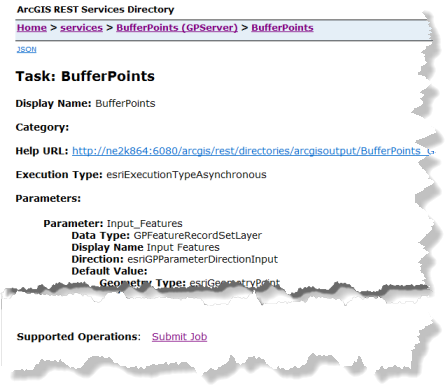Geoprocessing tasks
A geoprocessing task is a child resource of geoprocessing service and provides unique geoprocessing functionality. The client requests to execute a task and provides input values for the task. The server executes the task and returns output values to the client. Each geoprocessing task has its own task parameters and supports either the Execute Task or Submit Job operation based on the execution type of the parent geoprocessing service. The access URL for a geoprocessing task is http://<gpservice-url>/<taskName> and it is also called the task page. The clients can access the task page in a web browser to find information on the task parameters and task operation.
Task parameters
The task parameters are the inputs and outputs of a geoprocessing task and vary from task to task based on its geoprocessing functionality. Each parameter has a set of properties that provide information such as name, data type, required or optional, and so on. See Task parameter properties (REST) for more information about task properties.
Task operation
Each geoprocessing task will support either the Execute Task or Submit Job operation. If the execution mode of the geoprocessing service is synchronous, Execute Task (execute) is supported. If the service is asynchronous, Submit Job (submitJob) is supported. Both operations cause the task to be executed. See Task operation: execute (REST) and Task operation: submitJob (REST) for more details.
Tasks in web browser
When you access the geoprocessing service REST URL in a browser (also known as the service page in the services directory), the geoprocessing tasks will be listed with HTML links. When you click the task link, you will be led to the geoprocessing task page. The illustration below shows the task page of an example BufferPoints geoprocessing task.

The geoprocessing task page provides information on the task, lists the parameters of the task, and provides information on each parameter, such as their data type, direction (input or output), parameter type (required or optional), and so forth. At the bottom of the task page there is information on supported operations of the task which would be Submit Job or Execute Task with an HTML link. In the example, notice the Execution Type of the geoprocessing task is Asynchronous; therefore, the supported operation is Submit Job.